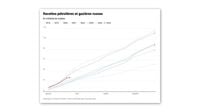As the world watches closely, Russia finds itself grappling with a significant economic crisis in early April 2025, primarily driven by plummeting oil prices. The price of American oil nearly hit $60 per barrel, a level not seen since April 2021, before stabilizing around $61. Meanwhile, Russian crude oil, known as Urals, is trading at approximately $50, marking a historically low price for 2023. This dramatic downturn poses serious questions about the sustainability of Russia's economy, which is heavily reliant on oil and gas revenues to fund its military operations in Ukraine.
According to the Russian Ministry of Finance, oil and gas revenues dropped by 17% year-on-year in March 2025, totaling 1,080 billion rubles. From January to March, revenues fell by 10%, reaching 2,640 billion rubles. This downward trend is largely attributed to sanctions imposed by the United States, which have forced Russia to offer discounts on its oil, coupled with a slight strengthening of the ruble against the dollar. A package of sanctions dubbed the "farewell package," imposed on January 10, 2025, targeted 160 vessels and could result in a loss of 10 to 20% of Russia's oil sales revenues.
In its budget, Russia projected a decrease of about 3% in oil and gas revenues compared to 2024, estimating these revenues would reach 10.9 trillion rubles (approximately $113 billion) in 2025. The government was banking on an average annual oil price of $69.7 per barrel. However, following announcements from President Donald Trump regarding reciprocal tariffs on March 2, and OPEC+'s decision to significantly increase production on April 3, oil prices have reached their lowest levels in four years, dipping below $60 on April 7.
In February, the Ministry of Finance had already indicated a downward revision of its forecasts, expecting the average oil price in 2025 to be closer to $60. As of April 4, prices for Russian Urals oil at ports like Primorsk and Novorossiisk fell to approximately $53 per barrel. The International Institute for Strategic Studies noted that 2025 could mark the first year where oil and gas revenues no longer compensate for skyrocketing military expenditures.
In January and February 2025, oil and gas revenues accounted for nearly 30% of federal budget revenues. As the economic situation worsens, President Vladimir Putin is pushing for a lifting of sanctions during ongoing discussions with the United States. Negotiations for a ceasefire in Ukraine are expected to continue this week, with Russian negotiator Kirill Dmitriev indicating that talks are ongoing. Meanwhile, Ukrainian President Volodymyr Zelensky accepted a partial ceasefire starting March 11, but Russia remains cautious.
U.S. Secretary of State Marco Rubio has expressed that Washington is losing patience with the "discussions about discussions" regarding the ceasefire. The options available to Moscow for compensating revenue losses are limited, with sovereign wealth fund assets having dwindled from 7.4% of GDP to less than 2% as of January 2022. This fiscal crisis is compounded by the fact that the Russian economy is already under strain from ongoing military operations and international sanctions.
Despite the bleak outlook, there are signs of a slight recovery in oil prices, surprising many analysts and investors. After several days of severe decline, prices began to recover, marking a modest increase of around 1% in recent sessions. This rebound can be attributed to a relative stabilization of trade tensions between major global economies, particularly between the U.S. and China. However, the underlying concerns about a potential global recession continue to weigh on oil demand.
While the oil market has shown some signs of recovery, the overall landscape remains precarious. The fragile balance between global oil production and demand, along with geopolitical factors, continues to create uncertainty. The recent increase in U.S. tariffs has raised fears of a recession, which could further diminish oil demand. The market is closely monitoring inventory levels and production rates in key countries, including the U.S. and OPEC members, as any increase in supply coupled with unstable demand could reverse recent price gains.
As the situation develops, the implications for Russia's economy are profound. With oil prices at such low levels, the Kremlin is acutely aware of the risks to its budget, which relies heavily on oil and gas exports. The central bank is reportedly considering technical measures to mitigate the impact of falling prices, but the outlook remains grim. Some experts suggest that budget cuts may be necessary, particularly in defense and security sectors, which account for nearly 9% of the budget this year.
For Ukraine, this situation presents an opportunity. Ukrainian officials are optimistic that the decline in oil prices will weaken Russia's military capabilities, with one high-ranking official stating, "The lower oil prices fall, the less funding they will have for their war." However, whether this economic strain will significantly alter the conflict's trajectory remains uncertain.
As the global oil market remains volatile, the coming months are critical for both Russia and Ukraine. The interplay of economic pressures and military strategies will shape the future of the region. With each fluctuation in oil prices, the stakes rise, underscoring the importance of energy resources in geopolitical power dynamics. The world watches as Russia navigates these turbulent waters, with the potential for significant ramifications for its economy and military operations.







